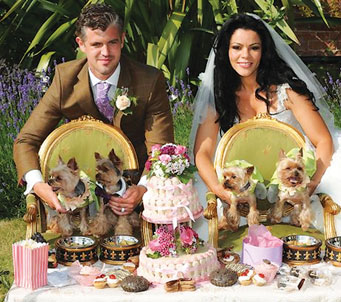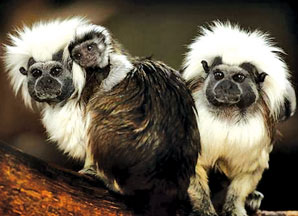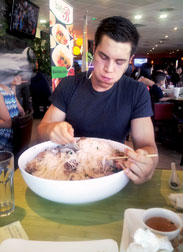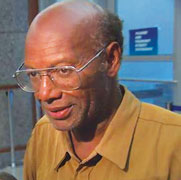|

Four dogs take centre stage at bizarre wedding
Will it be a dog’s life for the bridegroom, Daniel Hill after tying
the knot with Louise Harris who was adamant that her four Yorkshire
terriers be present at this important ceremony?

Yappiest day of their life: Daniel, Louise and their dogs |
This was what every guest who attended the bizarre wedding of Channel
4 superscrimper Daniel Hill and the lovely bride Louise Harris may have
felt. “For me it was important the dogs were included in my big day and
had everything they needed. Their two nannies were flown in from Spain
and there was a doggie day-crèche because weddings can get a bit boring
and I didn’t want the dogs sitting around with nothing to do,” Louise
said as the pooches were escorted down the aisle by four of the bride’s
friends.
And true to form, Lola, aged nine, Lulu, six, Lolly and Larry, wore
outfits for Louise’s nuptials, with “page boy” Larry in a purple bow tie
and morning suite and Lulu, Lolly and “chief bridesmaid” Lola in
matching green.
Louise who looked into every detail said: “The weather was quite warm
so there were paddling pools, toys and each dog had a four- poster bed
in a chill out area. I also shipped in about £350 worth of doggie
treats. The ice cream man was paid extra to make a selection of mini
cones so the dogs could have ice creams at the same time as my guests.”
Louise, who had considered a mansion in Tuscany for her wedding, finally
picked Woodhall Manor in Suffolk for her three-day, £130,000 celebration
earlier this month. She said: “The dogs were definitely the deciding
factor for the venue. They have always played a vital role in my life.
“I wouldn’t have got married any place where I couldn’t have them
with me. It ended up being the perfect day. It was even more
overwhelming when I watched the dogs being carried down the aisle.” She
will be hoping her marriage lasts longer than that of her much-loved
Lola. In April 2011 Louise splashed out an incredible £20,000 for Lola’s
“wedding” to Mugly, holder of the title world’s ugliest dog. But the
union ended in “divorce” a year later because they rarely saw each
other.
First example of whispering
observed in non-human primates
Researchers noticed tamarin monkeys communicating with each other at
a ‘reduced amplitude’ in the presence of zoo staff they disliked
 The first example of whispering by non-human primates has been
observed amongst a group of tamarin monkeys in captivity in New York
City’s Central Park Zoo. The first example of whispering by non-human primates has been
observed amongst a group of tamarin monkeys in captivity in New York
City’s Central Park Zoo.
The group of cotton-top tamarins were being observed in order to
study their use of human-directed mobbing calls (signals made by groups
of prey to confuse and intimidate predators).
However, scientists observed that when a particularly disliked member
of zoo staff entered the tamarins’ habitation the primates did not make
mobbing calls but instead communicated with one another using “low
amplitude vocalisations”.
The research concluded that “the tamarins were reducing the amplitude
of their vocalisations in the context of exposure to a potential
threat”.
In other words the primates - like many humans - felt it was prudent
to keep quiet when a disliked or dangerous individual was around.
The zoo keeper in question had been involved in the capture of the
tamarins, with the family of five previously exhibiting “a strong
mobbing response” in his presence.
Tamarins are squirrel-sized monkeys found in the tropical rainforests
of Central and South America.
They can live for up to 18 years in groups of up to 40 individuals.
Cotton-tail tamarins (which typically weigh around 0.5kg each) have
been extensively studied, with the research describing the species as
“highly cooperative and vocal” with command of “a repertoire of call
types [used] in contexts of feeding, group cohesion, investigation, mild
alarm, and high arousal”.
The Independent
How old is the moon? Scientists put formation forward 100 million years
Rock samples from Apollo 16 mission finally analysed show the moon is
millions of years younger than previously thought
 The moon is much younger than scientists have been led to believe,
according to researchers analysing samples taken from the Apollo 16
mission. The prevailing theory surrounding the creation of the moon is
that a Mars-sized body known as Theia collided with a newly formed
proto-earth approximately 4.56 billion years ago, shortly after the
formation of the solar system. The moon is much younger than scientists have been led to believe,
according to researchers analysing samples taken from the Apollo 16
mission. The prevailing theory surrounding the creation of the moon is
that a Mars-sized body known as Theia collided with a newly formed
proto-earth approximately 4.56 billion years ago, shortly after the
formation of the solar system.
The massive impact caused melted material to break off into pieces in
space, before eventually re-joining to form the moon.As the Moon cooled,
this magma ocean solidified into different mineral components, the
lightest of which floated upwards to form the oldest layer of crust. New
analysis of material collected from it's surface suggests that the moon
is 100 million years younger than previously thought.
A piece of lunar rock sample gathered in the Apollo 16 mission of
1972 has been analysed by researchers at the University of Copenhagen,
using newly refined techniques to assess the age of the sample. The team
of scientists, led by James Connelly from the Centre for Star and Planet
Formation, examined the isotopes of the elements lead and neodymium to
place the age of a sample of a FAN at 4.36 billion years.
This is significantly younger than earlier estimates, which put the
moon's age as nearly as old as the solar systems - 4.567 billion years.
Mr Connelly said: “Although the samples have been carefully stored at
NASA Johnson Space Center since their return to Earth, we had to
extensively pre-clean the samples using a new method to remove
terrestrial lead contamination.
“Once we removed the contamination, we found that this sample is
almost 100 million years younger than we expected.” The new, younger age
obtained for the oldest lunar crust is similar to ages obtained for the
oldest terrestrial minerals - zircons from Western Australia -
suggesting that the oldest crust on both Earth and the Moon formed at
approximately the same time.
The Independent
Food for fees
|

Eric Dahl gulping down food at a competition |
You might wonder whether the world has gone bonkers when some one
says that he is eating for his education or whether that fellow is nuts
to utter something absurd like that. Eric Dahl, a computer engineering
undergraduate from the University of Wisconsin said it has become part
of his life and an excellent income-earner to complete his higher
studies.
He is munching his way through university after earning more than
$18,000 (£11,200) in all-you-can-eat competitions, which goes straight
on his fees.
Dahl began competitive eating in 2011 after realising one night that
he didn’t have to pay for a meal if he ate it quickly enough. The
restaurant, Big Red’s Steakhouse, had offered customers a challenge:
finish a three-pound cheese-steak sandwich in less than 10 minutes and
you get the food for free.
He completed the task in five minutes 50 seconds and ‘it just started
rolling from there,’ he said.
In an interview he added: ‘I’m eating for my education. It helps me
get through.’ He pulled in his first monetary winnings after gulping
down nine pulled pork sandwiches in six minutes at Dickey’s Barbeque Pit
and took home $250 (£150).
The super-fit 6ft 3in athlete has a strict fitness regime - he lifts
weights twice a week, walks a few miles a day and plays hockey. Dahl –
who also goes by the stage name Silo - was at one point ranked first in
the All Pro Eating league tables but has since slipped to third place,
though this hasn’t affected his massive following.
‘I really get pumped when the crowd starts cheering,’ he said.
Honesty made him rich
|

Poor man's honesty makes him rich |
Although he was poor and homeless 54-year-old Glen James was a honest
and god-fearing human being.
He proved it by returning a backpack containing $2,400 in cash and
nearly $ 40,000 in traveller’s cheques found at the South Bay Mall in
Boston.
The man who lost the backpack told workers at a nearby store and they
called police, who later returned the backpack to him. Virginia resident
Ethan Whittington read media accounts of Mr James’ honesty and started a
fund for him on a crowd-funding website.
The fund has since raised more than $100,000, including $182 (£114)
of pocket money saved up by two young children.
The Boston Police Department publicly thanked James, saying his
actions were “a remarkable tribute to him and his honesty”. James said
in a statement: “Even if I were desperate for money, I would not have
kept even a penny of the money I found.
“I am extremely religious. God has always very well looked after me. |

